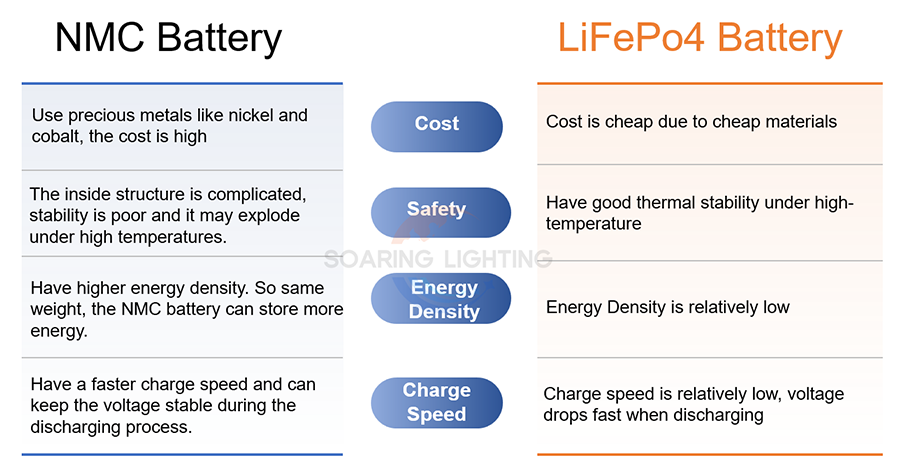Blog
NMC Batteries vs. LiFePo4 Batteries: A Comprehensive Comparison
NMC batteries
and LiFePo4 batteries represent two prevalent types of lithium-ion batteries
extensively utilized in the contemporary world. Each type boasts distinct
advantages and drawbacks, allowing users to make informed selections based on
specific application requirements.
1. NMC lithium battery
NMC lithium
batteries, also known as ternary batteries, typically refer to ternary polymer
lithium batteries. These batteries use lithium nickel cobalt manganese oxide
(Li(NiCoMn)O2) or lithium nickel cobalt aluminate as the cathode material.
1.1 Advantages
of NMC Battery:
a. High Energy
Density: NMC lithium
batteries exhibit superior energy density. When compared to LiFePo4 lithium
batteries of the same weight, NMC batteries can store more energy.
b. Excellent
Charge and Discharge Performance: NMC lithium batteries offer faster charging speeds and
maintain stable voltage during the discharging process.
c. High
Consistency: Battery cells produced in the same batch showcase closer voltage,
capacity, and internal resistance in NMC batteries. This is especially
beneficial for large battery packages with high voltage and capacity, ensuring
stable performance.
1.2
Disadvantages of NMC Battery:
a. Higher Cost: The use of precious metals such as
nickel and cobalt contributes to a higher manufacturing cost for NMC lithium
batteries.
b. Limited
Safety Under Extreme Conditions: NMC batteries may exhibit poor stability and, under
extreme conditions like high-temperature environments, there is a risk of
explosion in some cases.
2. LiFePo4 lithium battery
The
LiFePo4 battery, a lithium-ion battery, utilizes lithium iron phosphate
(LiFePo4) as the positive electrode material and carbon as the negative
electrode material.
2.1 Advantages of LiFePo4 Battery:
a. Enhanced Safety: LiFePo4 batteries demonstrate heightened
safety under high-temperature conditions and possess excellent thermal
stability.
b. Cost-Effective Solution: In
comparison to NMC lithium batteries, LiFePo4 batteries boast a lower
manufacturing cost.
c. Environmental Sustainability: LiFePo4
batteries are environmentally friendly as their materials lack heavy metals,
contributing to a greener battery option.
2.2 Disadvantages of LiFePo4 Battery:
a. Lower Energy Density: LiFePo4 batteries exhibit lower energy density, resulting in increased weight for the same capacity.
b. Moderate Charging Speed: When
compared to ternary lithium batteries, LiFePo4 batteries experience a
relatively slower charging speed.
3. Choosing Between NMC and LiFePo4
Batteries: A Comprehensive Guide
3.1 For Electric Vehicles:
When deciding between NMC and LiFePo4
batteries for electric vehicles, consider your priorities:
a. Mileage and Charging Speed Focus: Opt for NMC lithium batteries if you prioritize extended
mileage and faster charging.
b. Safety and Environmental Concerns: Choose lithium iron phosphate batteries if safety and
environmental protection are your primary concerns.
3.2 For Energy Storage or Solar Street
Lights:
For applications like energy storage or
solar street lights, lithium iron phosphate batteries may be the preferred
choice due to the cost-performance ratio: LiFePo4 batteries are more suitable
considering their cost and performance, especially under high-temperature
conditions.

If you have any queries or suggestions,
please don't hesitate to reach out. Our team of professional engineers is ready
to provide you with enhanced support.
